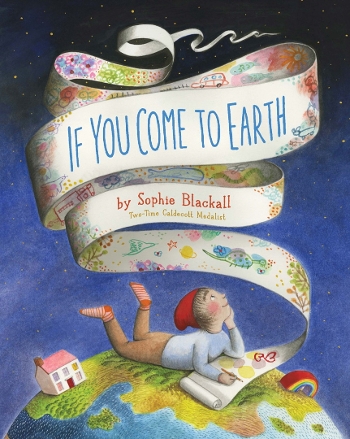How do you fit the whole world between the covers of a picture book? How do you describe our whole world to an alien? Narrator Quinn gives it a good shot in Sophie Blackall's stunning If You Come to Earth.
 How do you fit the whole world between the covers of a picture book? How do you describe our whole world to an alien?
How do you fit the whole world between the covers of a picture book? How do you describe our whole world to an alien?
Well, narrator Quinn gives it a good shot in If You Come to Earth. (Sophie Blackall avoids gendering Quinn for this book.) Quinn writes, “Dear Visitor from Outer Space, if you come to Earth, here’s what you need to know,” and Quinn’s efforts to describe Earth to a potential alien visitor result in an 80-page picture book, a book as big as life itself. It’s “the Earth book,” as my three-and-a-half-year-old friend Beau refers to it. Quinn writes of the planets and the seas and the lands of Earth, and the great diversity of people. Quinn writes of faces full of expression, of people gathered at tables to celebrate food and togetherness (sorely lacking in these days of COVID), of classrooms (modeled upon Blackall’s visit to Ms. Greta’s second-grade class at the Brooklyn New School), and of adults doing “lots of things.” There’s an image of Ruth Bader Ginsburg! And Carla Hayden!
The jacket art is a good place to begin a closer look at this gorgeous book, the illustrations rendered in India ink and watercolor. There’s Quinn pondering what to write on a scroll-like banner of a missive to alien forms, a banner also featured on the front endpapers and continued on the back endpapers, where it’s attached to a flying saucer! Take off the dust jacket, and surprise — it's what aliens might look like. (During school visits, Blackall asks students to imagine what an alien might look like, and she draws a creature as children come up with ideas for eyes and other features.) This certainly satisfies the Caldecott criterion of “excellence of presentation in recognition of a child audience.”
A series of double-page spreads in the middle of the book is stunning. “The sea looks empty,” Quinn writes, and the illustration depicts a calm sea, with a ship and an island on the horizon. Turn the page, and WOW — a riot of sea creatures demonstrating that the sea is actually full: a whale shark, a flounder, shrimp. There is so much for young readers to examine and to return to on subsequent readings. Same for the next double-page spread: land animals walking, galloping, hopping, and a bat boasting, “I can fly!” Then, the most amazing spread — a bird, perhaps a dove, whose form is composed of smaller birds. I think of it as a jigsaw puzzle of a bird. Amazing. Every page of this book supports the Caldecott criteria: excellent artistic technique, “excellence of pictorial interpretation of story, theme, or concept,” and so forth.
One part of the appeal of this book is the smaller visual elements. For example, what fun young readers will have when they realize that Quinn appears in many of the pages. “Where’s Quinn?” will become a game. Readers will also become accustomed to looking more closely; all is not always as it seems, as with that flying bat, or in the illustration about homes. “We live in all kinds of homes,” Quinn writes. But look closely: at the bottom of the page you’ll see people who have lost their homes “In a fire. In a flood. In a war.”
This is a book about all of us, but it’s also about each of us. While not overlooking homelessness or war or personal challenges, it makes us feel good no matter who we are. I’m an old bald white guy with a gray beard: Hey, I’m in there, too! There are eight billion people on Earth, and this book will make each reader feel glad to be part of it all.
The penultimate double-page spread is another stunner. I think what makes Blackall’s illustrations so appealing — here and in all her books — is the rich softness of her palette, a warmth exuded. Here, a golden-yellow glittery comet streaks above the world we share, and a philosophical message to Earthlings: “There are lots of things we don’t know. We don’t know where we were before we were born or where we go when we die. But right this minute, we are here together on this beautiful planet.” When Sophie Blackall visited my school a while back, it was this image that made me so eager to see the finished book. And now it’s here. Will a third Caldecott Medal keep Quinn company on the book’s jacket?
[Read the Horn Book Magazine review of If You Come to Earth here]
This is a book readers will return to over and over again. I know my friend reports how often she sees Beau poring over the illustrations, seeing something new every time. I’m curious: for those of you reading this post, what things have you or your children enjoyed finding in the illustrations that I haven’t mentioned?

ALREADY A SUBSCRIBER? LOG IN
We are currently offering this content for free. Sign up now to activate your personal profile, where you can save articles for future viewing.








Add Comment :-
Be the first reader to comment.
Comment Policy:
Comment should not be empty !!!